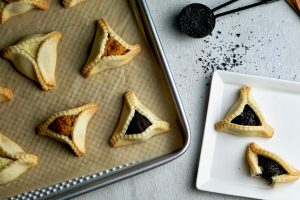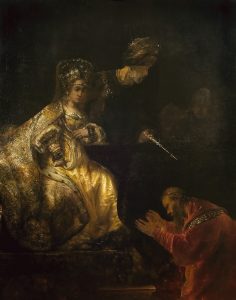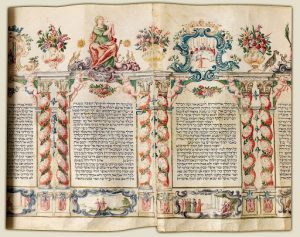This week marks the festive Jewish holiday of Purim, when the Bakehouse’s delicious Hamantaschen make their long-awaited star turn in the Bakeshop pastry case!
In keeping with Jewish tradition, we stuff our delectable, three-cornered, all-butter cookie pockets with an exceptional array of sweet fillings—the more traditional poppy seed and prune (with walnut) as well as the popular apricot and sweet cream cheese. Available for the entire month of March, our Hamantaschen are a Purim tradition celebrating the delicious sweetness of life!

Some History on Purim

By Rembrandt Harmenszoon van Rijn (Dutch: 1606 – 4 October 1669) and his studio.
A bright spot on the Jewish holiday calendar in late winter or early spring, Purim, which literally means “lots” and is also known as the Festival of Lots, celebrates the triumph of the Jewish people in ancient Persia over the evil minister Haman, vizier to King Ahasuerus of Persia, who plotted “to destroy, kill and annihilate all the Jews, young and old, infants and women, in a single day,” as recounted in The Book of Esther, one of five Scrolls (Megilliot) in the Hebrew Bible. In hatching his diabolical scheme, Haman convinces King Ahasuerus to issue the murderous decree and orders that lots (hence the name of the holiday) be cast in his presence to determine the day his plot is to be carried out: the 13th day of the Hebrew month of Adar.
In the end, Haman’s plans are heroically foiled by the intervention of Esther, Queen of Persia and her cousin and adoptive father Mordecai, who are both of Jewish descent themselves. When King Ahasuerus discovers that his wife, Esther, is Jewish, (which she had kept hidden from the King up to that point, upon the advice of Mordecai), he decides to reverse Haman’s decree, and instead of the Jews being killed, Haman, his sons, and other enemies are killed. The day of Jewish deliverance thus becomes a day of feasting and rejoicing.
Purim Rituals and Customs
A joyous holiday, Purim affirms and celebrates Jewish survival and continuity throughout history. According to the Book of Esther [9:22], “the days wherein the Jews had rest from their enemies, and the month which was turned unto them from sorrow to gladness, and from mourning into a good day; that they should make them days of feasting and gladness, and of sending portions one to another, and gifts to the poor.”
Purim is observed every year during the Hebrew month of Adar, either on the 14th or 15th, with joyous celebrations that include exchanging gifts of food and drink known as mishloach manot; donating charity to the poor known as mattanot la-evyonim, eating a celebratory meal, where wine is prominently consumed, known as se’udat Purim; and a public recitation (“reading of the megillah”) of the Purim story—usually in synagogue—from the Book of Esther, with noisemakers, called graggers, to drown out all mention of Haman’s name throughout the reading.

Other customs and rituals include wearing masks and costumes, a la Mardi Gras masquerades, which dates back centuries, possibly to medieval Italy, as well as performing skits and songs, participating in public celebrations and parades, drinking wine, and last, but not least, eating hamantaschen.
Some history on Hamantaschen, Purim’s signature sweet treat
Giora Shimoni, in her online article, “Why Do Jews Eat Hamantaschen Pastries on Purim?”, gives a succinct account of hamantaschen’s evolution as Purim’s signature sweet treat:
The tradition to eat hamantaschen on Purim appears to have begun in Europe. The name is derived from two German words: mohn (poppy seed) and taschen (pockets). Mohntaschen, or “poppy seed pockets,” were a popular German pastry dating from medieval times. Around the late 1500s, German Jews dubbed them Hamantaschen, or “Haman’s pockets.” The play on words likely references the rumor that the evil Haman’s pockets were filled with bribe money. Plus, mohn sounds like Haman…
…Another popular explanation for the hamantaschen’s shape is that it represents Haman’s three-cornered hat. These are often imagined as the “cocked hats” popular in Colonial America, or as Napoleon’s distinctive topper. But these styles were not in fashion in Haman’s time, and it’s unlikely he ever wore hats like these. It’s much more probable that over the centuries, as hats came into vogue that resembled hamantaschen, an association between Haman’s alleged hat and the pastries was born.
As for other explanations for hamantaschen’s triangular shape, Shimoni notes a couple more.  One stems from a “Midrash (Jewish commentary on the Hebrew Scriptures) that describes Haman bent over and shamed, with ‘oznayim mekutafot’ (the phrase has been mistranslated to mean clipped—or cut off—ears, though twisted ears would be more accurate). In Israel, hamantashen are called oznei haman, which means Haman’s ears. But originally, oznei haman referred to a different type of pastry altogether: fried dough drenched in honey or sugar syrup that was popular throughout the Sephardic world.”
One stems from a “Midrash (Jewish commentary on the Hebrew Scriptures) that describes Haman bent over and shamed, with ‘oznayim mekutafot’ (the phrase has been mistranslated to mean clipped—or cut off—ears, though twisted ears would be more accurate). In Israel, hamantashen are called oznei haman, which means Haman’s ears. But originally, oznei haman referred to a different type of pastry altogether: fried dough drenched in honey or sugar syrup that was popular throughout the Sephardic world.”
Yet another explanation dispenses with direct references to the evil and shamed Haman all together, focusing instead on Purim’s heroine, Queen Esther. Alfred Kolatch, in his The Jewish Book of Why, argues that the three corners of the hamantaschen possibly signify Queen Esther’s ancestors from whom she derived great strength–the three Patriarchs of the Bible, Abraham, Isaac, and Jacob. Other scholars posit, Shimoni notes, that the “traditional poppy seed filling was a nod to Esther’s vegetarian diet in Achashverosh’s palace—she is said to have lived on seeds, nuts, and legumes, in order to keep kosher under the radar. And regardless of what’s inside, the filling is partially covered by dough—just as G-d’s role was veiled in the Purim story.“
Historically, the tradition of eating hamantaschen on Purim, whichever explanation for the cookie’s shape one believes, plays directly into the story and is meant as a way to symbolically destroy Haman’s memory and all the evil that he represents. Today, cites Shimoni, hamantaschen are “usually an iconic fixture of mishloach manot, the holiday gift exchange of food and wine, and the sugary fuel for raucous Purim festivities.”
After a long, established career as a Ph.D. art history scholar and art museum curator, Lee, a Michigan native, came to the Bakehouse in 2017 eager to pursue her passion for artisanal baking and to apply her love of history, research, writing, and editing in a new exciting arena. Her first turn at the Bakehouse was as a day pastry baker. She then moved on to retail sales in the Bakeshop, followed by joining the Marketing Team and becoming the Bakehouse’s designated culinary historian. In addition to her retail sales and marketing work, she’s a member of the Bakehouse’s Grain Commission, co-author and editor of the Bakehouse's series of cookbooklets, and a regular contributor to the BAKE! Blog and Zingerman’s Newsletter, where she explores the culinary, cultural, and social history and evolution of the Bakehouse’s artisan baked goods.

